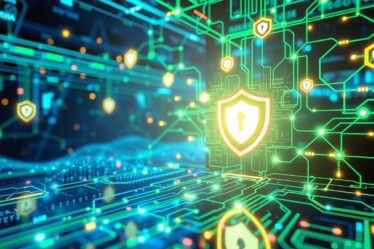THE Internet of Things (IoT) changes how we interact with the world. It connects connected objects to the internet, allowing them to share data automatically. This makes life easier, with technology present in everything.
With digitalization, the IoT is more present in our lives than ever before. It ranges from smart home appliances to complex industrial systems. This combination of devices brings many advantages, making everything more efficient and connected.
Main Points
- THE Internet of Things connects physical objects to the internet.
- THE automation is facilitated through smart devices.
- Ubiquitous computing improves the efficiency of everyday activities.
- IoT is essential in modern homes, cities and industries.
- Devices collect and share data in real time.
What is the Internet of Things?
THE Internet of Things allows physical objects to connect to the internet. They exchange information in real time. Devices such as home appliances and vehicles are equipped with sensors and software.
This technology allows these objects to communicate with each other. This improves the management of our daily lives and urban infrastructure.
Definition and Concept
Devices connect, process data and communicate with each other. This transforms how we interact with the world. IoT improves areas such as health and agriculture.
Constant innovation makes IoT evolve. More and more people are using this technology.
History and Evolution of IoT
IoT began to take shape in the 1990s. The Internet became popular around this time. Kevin Ashton proposed the term “Internet of Things” in 1999.
Since then, technology has evolved a lot. It has included machine learning and artificial intelligence. These innovations have improved everyday life and business operations.
How the Internet of Things Works
THE Internet of Things use smart devices. They have sensors that collect data from the environment. This shows how IoT works, interconnecting and communicating devices to automation.
Smart Devices and Sensors
You smart devices are the basis of IoT. They use sensors to measure things like temperature and movement. For example, a thermostat adjusts the temperature automatically.
With technologies like Wi-Fi and Bluetooth, these devices work on their own. They are very effective.
Machine to Machine Communication
THE M2M is essential for IoT. It allows devices to exchange information without the need for humans. This makes communication safe and fast.
This communication helps in many things. For example, in remote monitoring and industrial automation. Speed and accuracy are very important.
| Device Type | Sensors Used | Communication Protocols |
|---|---|---|
| Smart Thermostat | Temperature, Humidity | Wi-Fi, Zigbee |
| Security Camera | Movement, Light | HTTP, RTSP |
| Smart Watch | Heartbeat, Steps | Bluetooth, ANT+ |
Practical Applications of the Internet of Things
The Internet of Things changes everyone's lives. It ranges from home automation to urban and industrial changes. These changes make our lives more efficient, comfortable and sustainable.
Home Automation
THE home automation makes homes smarter and more economical. With connected devices, like lamps and thermostats, you can control your home from afar. This brings practicality and savings.
This technology not only makes life easier, but also makes homes safer.
Sensor Networks in Smart Cities
To the smart cities use sensor networks to collect real-time data. They help manage traffic and air quality. This technology is crucial for a digital urbanism efficient.
They improve infrastructure management and increase public safety. This makes cities more efficient and improves the lives of citizens.
Cyber-Physical Systems in Industry
In industry, the cyber-physical systems are essential for the industry 4.0. They connect physical processes to computer systems, enabling real-time monitoring. This improves efficiency and reduces costs.
THE industrial automation and the connection between machines and software increases productivity. They also allow predictive maintenance, reducing unwanted downtime.
Challenges and Opportunities of the Internet of Things
The Internet of Things is advancing rapidly. But we face challenges in taking full advantage of this technology. data security and the privacy are important questions. This is because connected devices are increasingly part of our lives.
Data Security and Privacy
You IoT risks are real. Connected devices collect sensitive data. It is essential that companies protect this information with encryption and authentication.
If they don't do this, trust in technology could drop significantly.
Impact on the Economy and the Labor Market
The Internet of Things is changing the economy. It drives innovation and creates new opportunities. But it also changes the job market.
With the automation, some roles may be replaced. Workers need to learn new skills. Education and training are key to adapting to the future.
| Challenges | Opportunities |
|---|---|
| Increase in cyber attacks | Creation of new business models |
| Problems of privacy of data | Innovation in cybersecurity |
| Unemployment due to automation | Development of new skills |
| Obsolescence of traditional functions | Adoption of new technologies |
Conclusion
The Internet of Things has changed our daily lives. It connects devices and allows us to interact with the world in new ways. As we explore what IoT can do, we see a future full of incredible innovations.
From home automation to advanced industrial systems, IoT is booming. But it’s crucial that this advancement is done safely and ethically. This way, we can create a more connected, efficient and sustainable future.
The potential of IoT is making us think again about work, life and the environment. Every innovation brings us closer to a better future. As we navigate this interconnected world, our journey is just beginning.
FAQ
What is the Internet of Things (IoT)?
The Internet of Things (IoT) is when smart devices connect to each other over the internet. They collect and share data. This helps in automation and computing everywhere.
What are the main devices used in IoT?
In IoT, we use smart sensors and thermometers. We also use connected cameras and appliances that we control from afar. Examples are refrigerators and light bulbs.
How does communication between devices work in IoT?
IoT devices communicate using protocols. This allows data to be exchanged without the need for humans. This means everything works efficiently.
What are some practical applications of the Internet of Things?
IoT helps a lot at home. For example, we control thermostats and locks from afar. It is also used in smart cities to improve urban life.
What are the challenges faced by the Internet of Things?
The biggest challenges are security and privacy. Connected devices can be attacked. In addition, there is the impact on the economy and changes in work.
How can IoT impact the industry?
In industry, IoT improves automation. This makes production more efficient. And it allows maintenance to be performed before it is needed, saving time and money.


